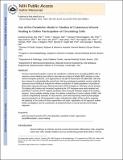| dc.contributor.author | Song, Guodong | |
| dc.contributor.author | Nguyen, Dinh T. | |
| dc.contributor.author | Pietramaggiori, Giorgio | |
| dc.contributor.author | Scherer, Saja | |
| dc.contributor.author | Chen, Bin | |
| dc.contributor.author | Zhan, Qian | |
| dc.contributor.author | Ogawa, Rei | |
| dc.contributor.author | Yannas, Ioannis V. | |
| dc.contributor.author | Wagers, Amy J. | |
| dc.contributor.author | Orgill, Dennis P. | |
| dc.contributor.author | Murphy, George F. | |
| dc.date.accessioned | 2013-07-10T20:05:17Z | |
| dc.date.available | 2013-07-10T20:05:17Z | |
| dc.date.issued | 2010-06 | |
| dc.date.submitted | 2009-04 | |
| dc.identifier.issn | 10671927 | |
| dc.identifier.issn | 1524475X | |
| dc.identifier.uri | http://hdl.handle.net/1721.1/79574 | |
| dc.description.abstract | Previous experimental studies to assess the contribution of blood-borne circulating (BBC) cells to cutaneous wound healing have relied on discontinuous pulsing of labeled BBC elements or bone marrow transplant protocols. Such approaches do not allow the examination of stable BBC cells that have matured in a physiologically normal host. We have used a parabiotic murine model for cutaneous wound healing to evaluate the relative contribution of stable populations of peripheral blood cells expressing the green fluorescent protein (GFP) transgene in otherwise normal animals. Circulating cells (mature and immature) expressing the GFP transgene were easily detected and quantified in wounds of GFP− parabiotic twins during all evaluated stages of the healing response. Using multiple antibody probes, the relative contribution of various subsets of BBC cells could be comparatively assessed. In early wounds, some cells expressing mesenchymal epitopes were documented to be of hematopoietic origin, indicating the utility of this model in assessing cell plasticity in the context of tissue regeneration and repair. Application of this approach enables further investigation into the contribution of peripheral blood in normal and abnormal healing responses. | en_US |
| dc.description.sponsorship | National Institutes of Health (U.S.) (NIH 5 T32 HL007627- 22 Physician-Scientist Training Grant) | en_US |
| dc.description.sponsorship | National Institutes of Health (U.S.) (NIH/NIDDK (5 P30 DK36836-20)) | en_US |
| dc.description.sponsorship | Brigham and Women’s Hospital (Program in Dermatopathology core grant (SDRC)) | en_US |
| dc.description.sponsorship | National Institutes of Health. (U.S.). Department of Health and Human Services (Brigham and Women’s Hospital’s Program in Dermatopathology core grant (SPORE)) | en_US |
| dc.language.iso | en_US | |
| dc.publisher | John Wiley & Sons, Inc. | en_US |
| dc.relation.isversionof | http://dx.doi.org/10.1111/j.1524-475X.2010.00595.x | en_US |
| dc.rights | Creative Commons Attribution-Noncommercial-Share Alike 3.0 | en_US |
| dc.rights.uri | http://creativecommons.org/licenses/by-nc-sa/3.0/ | en_US |
| dc.source | PubMed Central | en_US |
| dc.title | Use of the parabiotic model in studies of cutaneous wound healing to define the participation of circulating cells | en_US |
| dc.type | Article | en_US |
| dc.identifier.citation | Song, Guodong, Dinh T. Nguyen, Giorgio Pietramaggiori, Saja Scherer, Bin Chen, Qian Zhan, Rei Ogawa, et al. Use of the Parabiotic Model in Studies of Cutaneous Wound Healing to Define the Participation of Circulating Cells. Wound Repair and Regeneration 18, no. 4 (July 8, 2010): 426-432. | en_US |
| dc.contributor.department | Massachusetts Institute of Technology. Department of Biological Engineering | en_US |
| dc.contributor.department | Massachusetts Institute of Technology. Department of Materials Science and Engineering | en_US |
| dc.contributor.department | Massachusetts Institute of Technology. Department of Mechanical Engineering | en_US |
| dc.contributor.mitauthor | Yannas, Ioannis V. | en_US |
| dc.relation.journal | Wound Repair and Regeneration | en_US |
| dc.eprint.version | Author's final manuscript | en_US |
| dc.type.uri | http://purl.org/eprint/type/JournalArticle | en_US |
| eprint.status | http://purl.org/eprint/status/PeerReviewed | en_US |
| dspace.orderedauthors | Song, Guodong; Nguyen, Dinh T.; Pietramaggiori, Giorgio; Scherer, Saja; Chen, Bin; Zhan, Qian; Ogawa, Rei; Yannas, I.V.; Wagers, Amy J.; Orgill, Dennis P.; Murphy, George F. | en_US |
| dc.identifier.orcid | https://orcid.org/0000-0003-0151-708X | |
| mit.license | OPEN_ACCESS_POLICY | en_US |
| mit.metadata.status | Complete | |

